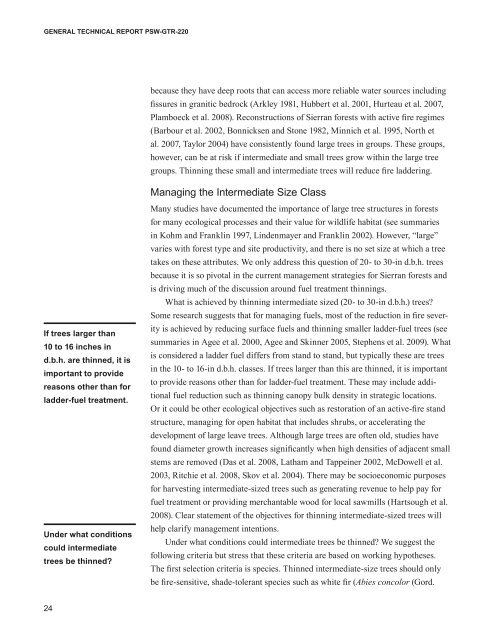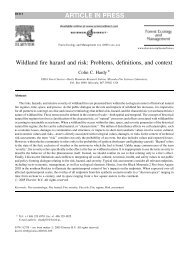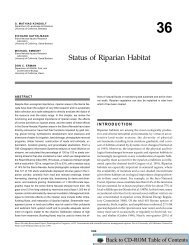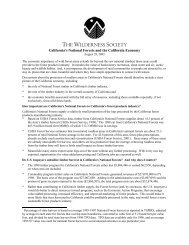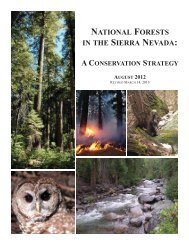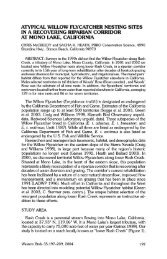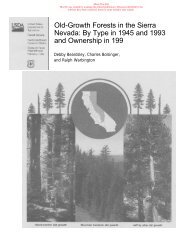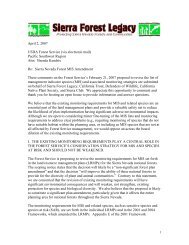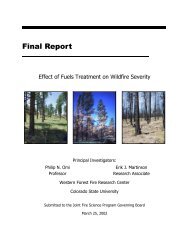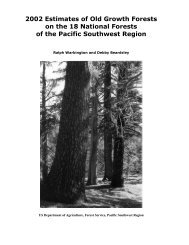An Ecosystem Management Strategy for Sierran Mixed-Conifer Forests
An Ecosystem Management Strategy for Sierran Mixed-Conifer Forests
An Ecosystem Management Strategy for Sierran Mixed-Conifer Forests
You also want an ePaper? Increase the reach of your titles
YUMPU automatically turns print PDFs into web optimized ePapers that Google loves.
GENERAL TECHNICAL REPORT PSW-GTR-220<br />
because they have deep roots that can access more reliable water sources including<br />
fissures in granitic bedrock (Arkley 1981, Hubbert et al. 2001, Hurteau et al. 2007,<br />
Plamboeck et al. 2008). Reconstructions of <strong>Sierran</strong> <strong>for</strong>ests with active fire regimes<br />
(Barbour et al. 2002, Bonnicksen and Stone 1982, Minnich et al. 1995, North et<br />
al. 2007, Taylor 2004) have consistently found large trees in groups. These groups,<br />
however, can be at risk if intermediate and small trees grow within the large tree<br />
groups. Thinning these small and intermediate trees will reduce fire laddering.<br />
Managing the Intermediate Size Class<br />
If trees larger than<br />
10 to 16 inches in<br />
d.b.h. are thinned, it is<br />
important to provide<br />
reasons other than <strong>for</strong><br />
ladder-fuel treatment.<br />
Under what conditions<br />
could intermediate<br />
trees be thinned?<br />
Many studies have documented the importance of large tree structures in <strong>for</strong>ests<br />
<strong>for</strong> many ecological processes and their value <strong>for</strong> wildlife habitat (see summaries<br />
in Kohm and Franklin 1997, Lindenmayer and Franklin 2002). However, “large”<br />
varies with <strong>for</strong>est type and site productivity, and there is no set size at which a tree<br />
takes on these attributes. We only address this question of 20- to 30-in d.b.h. trees<br />
because it is so pivotal in the current management strategies <strong>for</strong> <strong>Sierran</strong> <strong>for</strong>ests and<br />
is driving much of the discussion around fuel treatment thinnings.<br />
What is achieved by thinning intermediate sized (20- to 30-in d.b.h.) trees?<br />
Some research suggests that <strong>for</strong> managing fuels, most of the reduction in fire severity<br />
is achieved by reducing surface fuels and thinning smaller ladder-fuel trees (see<br />
summaries in Agee et al. 2000, Agee and Skinner 2005, Stephens et al. 2009). What<br />
is considered a ladder fuel differs from stand to stand, but typically these are trees<br />
in the 10- to 16-in d.b.h. classes. If trees larger than this are thinned, it is important<br />
to provide reasons other than <strong>for</strong> ladder-fuel treatment. These may include additional<br />
fuel reduction such as thinning canopy bulk density in strategic locations.<br />
Or it could be other ecological objectives such as restoration of an active-fire stand<br />
structure, managing <strong>for</strong> open habitat that includes shrubs, or accelerating the<br />
development of large leave trees. Although large trees are often old, studies have<br />
found diameter growth increases significantly when high densities of adjacent small<br />
stems are removed (Das et al. 2008, Latham and Tappeiner 2002, McDowell et al.<br />
2003, Ritchie et al. 2008, Skov et al. 2004). There may be socioeconomic purposes<br />
<strong>for</strong> harvesting intermediate-sized trees such as generating revenue to help pay <strong>for</strong><br />
fuel treatment or providing merchantable wood <strong>for</strong> local sawmills (Hartsough et al.<br />
2008). Clear statement of the objectives <strong>for</strong> thinning intermediate-sized trees will<br />
help clarify management intentions.<br />
Under what conditions could intermediate trees be thinned? We suggest the<br />
following criteria but stress that these criteria are based on working hypotheses.<br />
The first selection criteria is species. Thinned intermediate-size trees should only<br />
be fire-sensitive, shade-tolerant species such as white fir (Abies concolor (Gord.<br />
24


